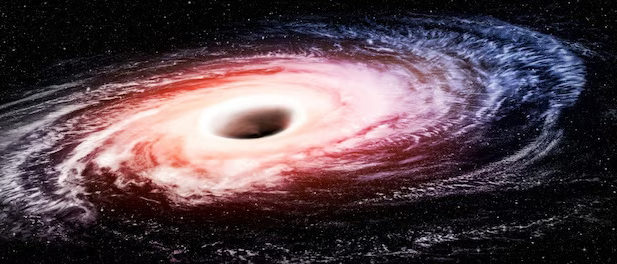Astronomers have found the black hole using bent light and gravity. They have identified that the ultramassive black hole, which possesses a mass equivalent to 30 billion suns, is at the center of a galaxy situated millions of light-years away from Earth.
While most black holes are usually called supermassive black holes but this one is so gigantic that it is called, an ultramassive black hole. The discovery was actually an accident. The astronomers were looking at a different galaxy, much farther than the one where the found the black hole.

A group of astronomers discovered the largest black hole known to mankind, using some really unconventional methods. The astronomers found the black hole using bent light and gravity.
Astronomers have identified that the massive colossal black hole, which possesses a mass equivalent to 30 billion suns, is at the centre of a galaxy situated millions of light-years away from our planet. Referred to as an ultramassive black hole, it distinguishes itself from the typical supermassive black holes found in galaxies, which typically range in mass from a few million to a few billion solar masses.

This mammoth black hole was detected by accident. The team of astronomers, lead by James Nightingale, an astrophysicist at Durham University in the UK were studying a galaxy that is positioned even farther from Earth than the one housing the enormous black hole.
James Nightingale, an astrophysicist at Durham University in the U.K. and lead author of the new study, said in a statement, ‘This particular black hole, which is roughly 30 billion times the mass of our sun, is one of the biggest ever detected and on the upper limit of how large we believe black holes can theoretically become, so it is an extremely exciting discovery.’

The team arrived at the size of the black hole by analyzing the magnification of the foreground object in a series of images taken by the Hubble Space Telescope. Using sophisticated computer modeling, the scientists were able to simulate how much light bends around the foreground galaxy where the black hole resides. They tested thousands of black hole sizes before arriving at a solution that matched the observations.
The black hole, located in one of the galaxies of the Abell 1201 galaxy cluster, is the first discovered using this technique. Although enormous, the black hole is not very active, meaning it’s not swallowing too much material and therefore not producing strong X-ray radiation. Such black holes are nearly impossible to study by other methods.

Most of the biggest black holes that we know about are in an active state, where matter pulled in close to the black hole heats up and releases energy in the form of light, X-rays, and other radiation,” Nightingale said. “However, gravitational lensing makes it possible to study inactive black holes, something not currently possible in distant galaxies. This approach could let us detect many more black holes beyond our local universe and reveal how these exotic objects evolved further back in cosmic time.”
To determine the size of this black hole, the team conducted a thorough analysis of the magnification exhibited by the foreground object in a sequence of images captured by the Hubble Space Telescope. Employing advanced computer modelling techniques, the scientists simulated the extent to which light bends around the foreground galaxy housing the black hole. By testing thousands of black hole sizes, they eventually identified a solution that aligned with the observed data.
(ref-space.com)
